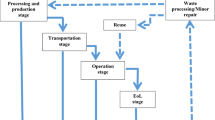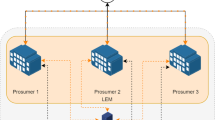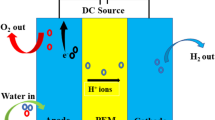Abstract
This research paper delves into the simulation of the power generation analysis of a 5 MWp solar photovoltaic (PV) plant using the design and simulation tool named PVsyst. It then proceeds to contrast the performance projected by the simulation with the real generation of an installed PV plant of the same capacity. The analysis encompasses a comparison between the genuine and simulated outcomes, underscoring the dependability and appropriateness of PVsyst. Moreover, the study evaluates key performance indicators according to the standard IEC 61724. The outcomes of the study reveal a strong connection between the projected and real system yields, which underscores the reliability of PVsyst in emulating PV system performance. Furthermore, the found that real system’s PV module, inverter and system efficiency was 11.27%, 97.49% and 11.27% respectively. PVsyst estimates a higher system efficiency as 11.39% than real system. While the actual system exhibited a performance ratio of 81.02% and a capacity utilization factor of 16.05%, the simulated system showed corresponding values of 80.42% for the performance ratio and 16.54% for the capacity utilization factor. These results underscore the potential of PVsyst as a dependable instrument for evaluating and refining rooftop solar PV systems, offering valuable insights for informed decision-making in the realm of solar energy.









Similar content being viewed by others
Data availability
All essential data is encompassed in the article. No additional data availability statement is required.
References
Suman S, Jasrotia R, Singh SP (2023) A MCDM-based framework for selection of photovoltaic cell technology using novel information measure under Pythagorean fuzzy environment. Int J Inf Technol. https://doi.org/10.1007/S41870-023-01525-Y
El Bourakadi D, Ramadan H, Yahyaouy A, Boumhidi J (2023) A novel solar power prediction model based on stacked BiLSTM deep learning and improved extreme learning machine. Int J Inf Technol. https://doi.org/10.1007/s41870-022-01118-1
Kumar Yadav S, Manoj Kumar N, Ghosh A, Bajpai U, Chopra SS (2022) Assessment of soiling impacts and cleaning frequencies of a rooftop BAPV system in composite climates of India. Sol Energy 242:119–129. https://doi.org/10.1016/J.SOLENER.2022.07.022
Annual Report 2018–19. https://mnre.gov.in/img/documents/uploads/file_f-1608040317211.pdf (Accessed 1 Mar 2023).
Kumar NM, Sudhakar K, Samykano M (2017) Techno-economic analysis of 1 MWp grid connected solar PV plant in Malaysia. Int J Ambient Energy 40(4):434–443. https://doi.org/10.1080/01430750.2017.1410226
Bentouba S, Bourouis M, Zioui N, Pirashanthan A, Velauthapillai D (2021) Performance assessment of a 20 MW photovoltaic power plant in a hot climate using real data and simulation tools. Energy Rep. https://doi.org/10.1016/j.egyr.2021.10.082
Markam K, Sudhakar K, Bhopal M (2016) Estimation of optimal tilt angle for solar photovoltaic installations in India. Int Res J Eng Technol 3(5):2735–2741
Ramanan P, KalidasaMurugavel K, Karthick A, Sudhakar K (2020) Performance evaluation of building-integrated photovoltaic systems for residential buildings in southern India. Build Serv Eng Res Technol. https://doi.org/10.1177/0143624419881740
Kumar NM, Gupta RP, Mathew M, Jayakumar A, Singh NK (2019) Performance, energy loss, and degradation prediction of roof-integrated crystalline solar PV system installed in Northern India. Case Stud Therm Eng 13:100409. https://doi.org/10.1016/J.CSITE.2019.100409
Kumar BS, Sudhakar K (2015) Performance evaluation of 10 MW grid connected solar photovoltaic power plant in India. Energy Rep 1:184–192. https://doi.org/10.1016/J.EGYR.2015.10.001
Zuhaib M, Khan HA, Rihan M (2021) Performance analysis of a utility-scale grid integrated solar farm considering physical and environmental factors. J Inst Eng Ser B. https://doi.org/10.1007/s40031-020-00500-6
Kumar NM, Kumar MR, Rejoice PR, Mathew M (2017) Performance analysis of 100 kWp grid connected Si-poly photovoltaic system using PVsyst simulation tool. Energy Procedia. https://doi.org/10.1016/j.egypro.2017.05.121
Baqir M, Kaur HC (2022) Analysis and design of solar PV system using Pvsyst software. Mater Today: Proc. https://doi.org/10.1016/j.matpr.2021.09.029
Shrivastava A, Sharma R, Kumar Saxena M, Shanmugasundaram V, LalRinawa M, Ankit (2023) Solar energy capacity assessment and performance evaluation of a standalone PV system using PVSYST. Mater Today Proc. https://doi.org/10.1016/j.matpr.2021.07.258
Ayompe LM, Duffy A, McCormack SJ, Conlon M (2011) Measured performance of a 1.72 kW rooftop grid connected photovoltaic system in Ireland. Energy Conversat Manag 52(2):816–825. https://doi.org/10.1016/J.ENCONMAN.2010.08.007
Manisha PG (2021) The survey of MPPT under non-uniform atmospheric conditions for the photovoltaic generation systems. Int J Inf Technol. https://doi.org/10.1007/s41870-020-00591-w
Sreedhar R, Chandrasekar P, Karunanithi K, Vijayakumar SC, Raja SP (2022) Design and validation of a single-phase buck–boost inverter with Grey Wolf optimization algorithm under partial shaded conditions. Int J Inf Technol. https://doi.org/10.1007/s41870-022-00948-3
Singh P, Ravindra NM (2012) Temperature dependence of solar cell performance—an analysis. Sol Energy Mater Sol Cells 101:36–45. https://doi.org/10.1016/J.SOLMAT.2012.02.019
Chakraborty V, Yadav SK, Bajpai U (2021) Thermal regulation of solar photovoltaic modules by incorporating phase change materials to enhance the yield. Lect Notes Electr Eng 616:341–350. https://doi.org/10.1007/978-981-16-1978-6_30
Kumar NM et al (2020) Operational performance of on-grid solar photovoltaic system integrated into pre-fabricated portable cabin buildings in warm and temperate climates. Energy Sustain Dev 57:109–118. https://doi.org/10.1016/j.esd.2020.05.008
Srivastava R, Tiwari AN, Giri VK (2020) An overview on performance of PV plants commissioned at different places in the world. Energy Sustain Dev 54:51–59. https://doi.org/10.1016/J.ESD.2019.10.004
Thotakura S, Kondamudi SC (2022) Operating temperature prediction and comparison for rooftop PV arrays in coastal climates of India. Environ Sci Pollut Res 29(29):43532–43545. https://doi.org/10.1007/S11356-022-20068-6/FIGURES/10
Malvoni M, Leggieri A (2017) Long term performance, losses and efficiency analysis of a 960 kWP photovoltaic system in the Mediterranean climate. Energy Convers Manag. https://doi.org/10.1016/j.enconman.2017.04.075
Baitule AS, Sudhakar K (2017) Solar powered green campus: a simulation study. Int J Low-Carbon Technol. https://doi.org/10.1093/ijlct/ctx011
Arora R, Arora R, Sridhara SN (2022) Performance assessment of 186 kWp grid interactive solar photovoltaic plant in Northern India. Int J Ambient Energy. https://doi.org/10.1080/01430750.2019.1630312
Dahmoun MEH, Bekkouche B, Sudhakar K, Guezgouz M, Chenafi A, Chaouch A (2021) Performance evaluation and analysis of grid-tied large scale PV plant in Algeria. Energy Sustain Dev. https://doi.org/10.1016/j.esd.2021.02.004
Acknowledgements
The researchers express their gratitude to Mr. C.H. Kiran Kumar, Senior Manager at NTPC, A&N Port Blair Island, Government of India, for granting permission to utilize the facilities to carry out the study.
Author information
Authors and Affiliations
Corresponding author
Rights and permissions
Springer Nature or its licensor (e.g. a society or other partner) holds exclusive rights to this article under a publishing agreement with the author(s) or other rightsholder(s); author self-archiving of the accepted manuscript version of this article is solely governed by the terms of such publishing agreement and applicable law.
About this article
Cite this article
Mishra, P.R., Rathore, S. & Jain, V. PVSyst enabled real time evaluation of grid connected solar photovoltaic system. Int. j. inf. tecnol. 16, 745–752 (2024). https://doi.org/10.1007/s41870-023-01677-x
Received:
Accepted:
Published:
Issue Date:
DOI: https://doi.org/10.1007/s41870-023-01677-x




